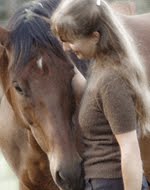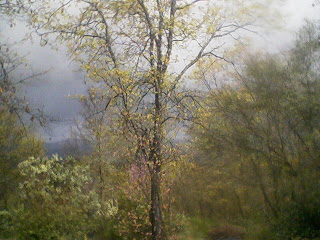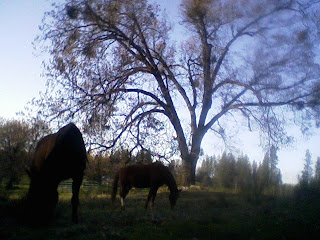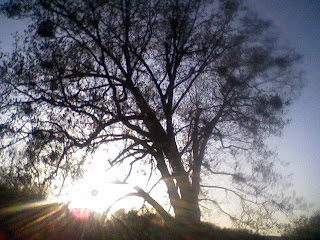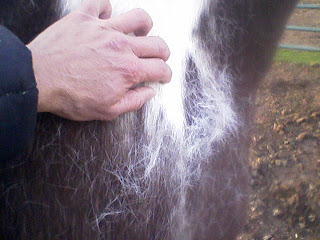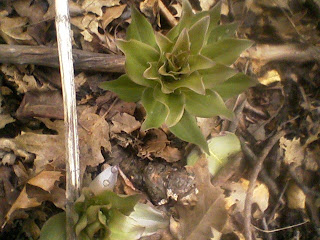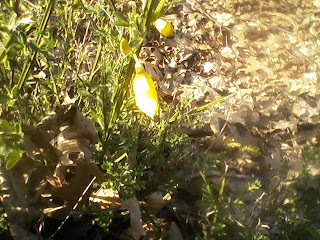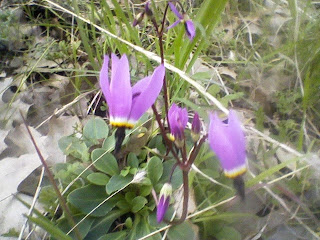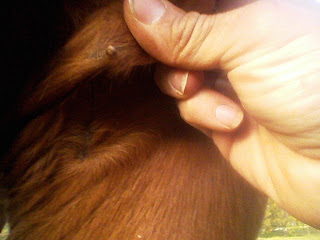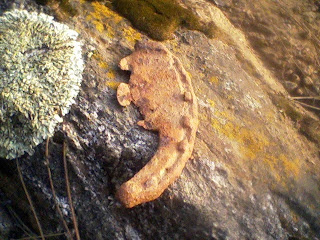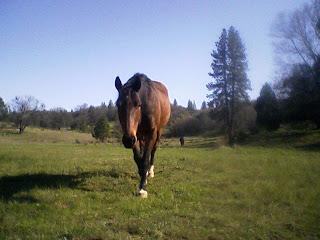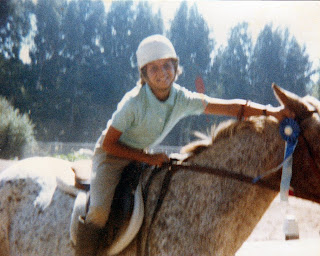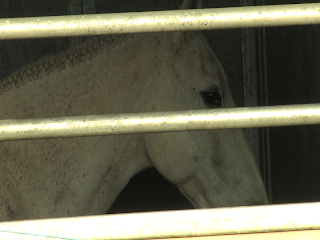Sunny has taken to more extreme measures to let me know he wants to go for a walk. Since I've been down with an aching back I haven't been able to take him out on our regular adventures. He's always been quite good at getting his intentions known but today he must have thought that I needed something more clear. He sat down next to me and put first one paw and then the other on the arm I had folded across my knees and then gave me the most pitiful "I NEED A WALK" face you've ever seen.
I know, I know Sunny...me too...

Mark Mottershead and I have been working on defining the different levels of how people relate with horses. What follows is a very rough draft but I thought it'd be nice to get feedback about what other people think of the specifics of this chart and the general value of having a chart like this. Most people will not fit solely in one category or another, but I think it's an interesting place to start creating a model. Oh, and for the record, now Alexander Nevzorov rides no longer than 5 minutes at a time.
LEVEL 4
No restraint* at any stage in training
Minimal (if any) riding (5 minutes maximum)
No use of pain or force
---------------
LEVEL 3
Short periods of riding (up to 20 minutes up to 2 times/week)
No bits
No spurs
Uses a combination of liberty and restraint*-based on-line (with a halter) training
Minimal use of pain or force (hitting, whipping, jerking a restrained horse)
No competition
---------------
LEVEL 2
Regular riding (typically over 20 minutes, more than 2-5 times/week)
May use bits
May use spurs
Most likely will spend more time using restraint*-based training than liberty training
May compete occasionally, but it is not the main focus of their relationship with a horse
May trailride
---------------
LEVEL 1
Regular riding (typically over 20 minutes, more than 3 times/week)
No aversion to using bits
No aversion to using spurs
Will likely rely on "gadgets" such as specialty bits, spurs, martingales, sidereins, etc. to achieve results
Will often use more restraint*-based training than liberty training
Likely to rely on pain or force (hitting, whipping, jerking a restrained horse) for results
Competition based training, result oriented
---------------
No restraint* at any stage in training
Minimal (if any) riding (5 minutes maximum)
No use of pain or force
---------------
LEVEL 3
Short periods of riding (up to 20 minutes up to 2 times/week)
No bits
No spurs
Uses a combination of liberty and restraint*-based on-line (with a halter) training
Minimal use of pain or force (hitting, whipping, jerking a restrained horse)
No competition
---------------
LEVEL 2
Regular riding (typically over 20 minutes, more than 2-5 times/week)
May use bits
May use spurs
Most likely will spend more time using restraint*-based training than liberty training
May compete occasionally, but it is not the main focus of their relationship with a horse
May trailride
---------------
LEVEL 1
Regular riding (typically over 20 minutes, more than 3 times/week)
No aversion to using bits
No aversion to using spurs
Will likely rely on "gadgets" such as specialty bits, spurs, martingales, sidereins, etc. to achieve results
Will often use more restraint*-based training than liberty training
Likely to rely on pain or force (hitting, whipping, jerking a restrained horse) for results
Competition based training, result oriented
---------------
*Restraint: any form of restricting the horse's movement which is potentially painful, including halters, bridles, neckropes used higher than the lower half of the neck.
Neckropes used gently on the lower half of the horse's neck and not tied to inanimate objects are not considered restraint.
As a separate topic, I'd like to write a little about the difference between rope halters and webbed/flat nylon or leather halters. Rope halters made it big in the 90s when they started being marketed as standard equipment for "natural horsemanship" training. Let's look behind the marketing hype and see what they actually do from a horse's perspective.
First off, the main characteristic is that they are made of a thin rope or cord, typically about 1/4" thick, doubled in some places such as over the poll and nose. The halter is held together by knots and some designs have additional knots in the nosebone area.
First off, the main characteristic is that they are made of a thin rope or cord, typically about 1/4" thick, doubled in some places such as over the poll and nose. The halter is held together by knots and some designs have additional knots in the nosebone area.
 Flat nylon and leather halters are typically constructed of 1" wide material without significant knots or bumps against the horse's face.
Flat nylon and leather halters are typically constructed of 1" wide material without significant knots or bumps against the horse's face.From here on out, it's simple physics. Smaller surface area = Greater force.
Sure, it may look like your horse prefers the light rope halter, but the moment it comes into action, whether by a human's pull, or the horse's pull when tied or he steps on the rope, the amount of force will be greatly multiplied. Maybe someone can help me out with the actual numbers, but let's think about the amount of force on the extremely sensitive poll area when two rounded 1/4" ropes dig in versus one 1" flat piece of leather or nylon. This isn't even taking into account the effect of the knots on certain delicate pressure points on a horses nasal bone.
It's no wonder horses seem to behave better in these halters, they are being subjected to significantly more pain. This is the same principle that makes stud chains effective. Their small size and bumpy profile guarantee that there is a smaller surface area and therefore the human can create greater pain with less force. In short, rope halters are a quick-fix substitute for a real relationship with your horse.
It's no wonder horses seem to behave better in these halters, they are being subjected to significantly more pain. This is the same principle that makes stud chains effective. Their small size and bumpy profile guarantee that there is a smaller surface area and therefore the human can create greater pain with less force. In short, rope halters are a quick-fix substitute for a real relationship with your horse.
When I was looking at halters on Ebay I came across this classic description:
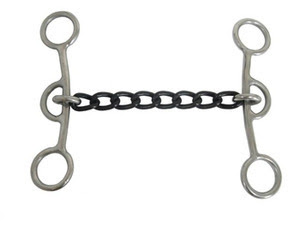
Or how about this one...
 The amount of misleading information about bits is mirrored throughout the other pieces of equipment that are typically found in any tackroom. But I'll stop myself here and get on to the day.
The amount of misleading information about bits is mirrored throughout the other pieces of equipment that are typically found in any tackroom. But I'll stop myself here and get on to the day.
My dad called this morning. I felt like Julie from the movie Julie/Julia. He had read on my blog that I wasn't feeling well and had a painful back. It must be a sign of the times when your parents know about you more quickly from your blog than in real life! I'm not sure that that's a good thing. He was the first to correctly identify the mystery plant though. Goes to show that this acorn didn't fall far from the tree.
Speaking of the mystery plant, I haven't been down to photograph it recently, maybe...back willing...I'll take Sunny for a little stroll down there tomorrow.
In the meantime, here are the redbuds...
The rope is 1/4 " Thick, it's thick enough not to hurt your horse, but very durable and keeps them from leaning on it.Well, why do you think the horse doesn't lean on it? Because it hurts!
Ok, now I'm really rolling. I used to be a "bit expert". I even produced a video called "Understanding Bits" and taught bitting clinics and wrote articles about bits. I'm going to indulge myself for a few moments and get this out of my system.
Here are two descriptions of bits currently for sale that make me cringe when I realize who must be reading and believing them. These are not relics from our ancient past, they are currently in production and use today:
...The small chain mouth conforms well to the bars and tongue making it comfortable for your horse to pack. This bit has light control and is excellent for training or relaxed pleasure riding...

Or how about this one...
...Distributes even pressure on nose, corners of mouth, bars, curb and poll. Excellent bit for a horse that needs a little more control in the turns.
My dad called this morning. I felt like Julie from the movie Julie/Julia. He had read on my blog that I wasn't feeling well and had a painful back. It must be a sign of the times when your parents know about you more quickly from your blog than in real life! I'm not sure that that's a good thing. He was the first to correctly identify the mystery plant though. Goes to show that this acorn didn't fall far from the tree.
Speaking of the mystery plant, I haven't been down to photograph it recently, maybe...back willing...I'll take Sunny for a little stroll down there tomorrow.
In the meantime, here are the redbuds...

And the beautiful smooth, red wood of the manzanita...
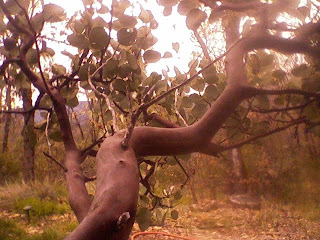
And the first leaves on the persimmon tree...
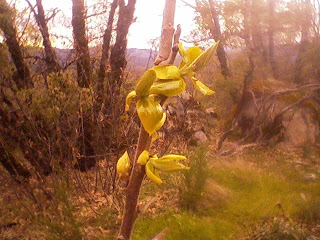
So, what I'd like from you readers is comments or questions about the levels of horse/human relationship chart and of course, anything else you'd like to add to the discussion.
